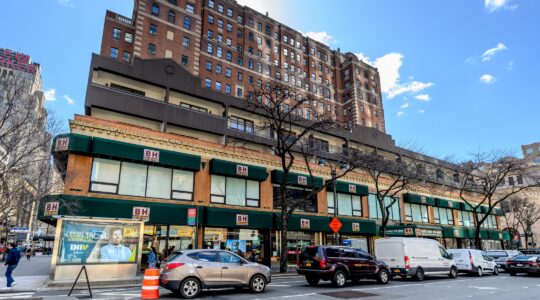NEW YORK (JTA) — I have roamed the Metropolitan Museum of Art’s Egyptian wing many times, marveling at sarcophagi, statues of Horus and Ra, and portraits of young men on ancient panels who gaze back at visitors, looking shockingly familiar and contemporary. But on a Sunday just before Passover, I viewed the artifacts as I’d never before seen them: through the lens of the Exodus story, which we retell each year through reading the Haggadah.
Nachliel Selavan, a Jewish educator and self-taught museum guide whose specialty is looking at Jewish texts and history through ancient artifacts, guided a group of about 20 through the Egypt section, pausing at statues, carvings and the Book of the Dead scroll. Before setting off he distributed source sheets with canonical Jewish texts in Hebrew and English. For more than two hours Selavan connected items and ideas mentioned in the texts with the artifacts on view.
Selavan had us look at a passage from Deuteronomy in which Moses details what will befall the Israelites if they don’t live up to their end of the covenant with God.
We looked through cases at the Met displaying little replicas of Egyptian life discovered in the tombs of embalmed rulers, intended to accompany the deceased on their journeys to the afterlife. In the Bible, the Israelites are told they will be flattened by insufferable ailments and curses, and that the Lord will “will bring you back in boats to Egypt,” so undesirable they can’t even sell themselves back into slavery. Selavan pointed inside one of the ancient dioramas to show what those boats would have looked like.
“The Jewish people and Tanach do not exist in a vacuum,” Selavan, using a term meaning the Hebrew Bible, said after the tour. “Understanding the context for the text is key to our identity. Artifacts help us realize that ‘oh wow, these were real people.’
“What was daily life like for regular Philistines or regular Israelites? What were they seeing as they traded and mingled with another culture? When you see material culture like this, it makes it real.”
Selavan brought us to several examples of reliefs carved with the names of the Egyptian ruler, or paro/pharaoh, noting how important names were to them. In Hebrew, he noted, the Book of Exodus is known as Shemot, or names, and begins with the names of the sons of the patriarch Jacob, who brought their families down to Egypt with their father.
“It was very interesting to see actual artifacts, representations of words we see in the Torah,” said Lori Leifer, 37, a Yiddish singer and computer database programmer who describes herself as Conservadox. She heard about the tour through Chulent, a WhatsApp group for Jews who have left Orthodox communities. Everyone else on the tour appeared to be Orthodox, including several haredim.
The Exodus tour is one of five Jewish tours Selavan offers at the Met through his company, Torah Intermedia. Another focuses on artifacts from the time of the Maccabee revolt and oriented toward Hanukkah. More Passover-themed tours are planned for the festival’s intermediate days.
“When you’re able to not just learn a text but see the stuff it’s talking about, the learning goes to a whole other level,” said Rabbi Ethan Tucker in an interview.
Tucker is the president and rosh yeshiva of Hadar, the egalitarian Torah learning center based in Manhattan. Last year Hadar brought its 45 summer fellows to the Met for a tour with Selavan. They were studying Avodah Zara, a Talmud tractate on idol worship, and saw examples of what the Talmud discusses.
“It was great to go around with someone with knowledge of Jewish sources and material sources on display at the Met,” Tucker said. “I found it to be very enriching. One of the struggles of being in a culture so focused on text is you can forget texts are talking about things in the real world. For institutions centered on the beit midrash [study hall], to get out into a museum raises the quality and intensity of the experience.”
Selavan is one of a handful of individuals and companies that offer private Jewish tours at major art museums.
David Thomas, associate coordinator of groups and visitor services at the Met, said the museum does not share the number of tours led by outside guides like Selavan.
“I’m not aware of any other tour guides who offer Jewish-themed tours, but there may be some,” Thomas said. “Many synagogues, universities and other Jewish organizations also bring groups.”
Selavan grew up the son of a rabbi/tour guide/archaeologist in the Jewish Quarter of Jerusalem’s Old City, and was educated at yeshivas. He discusses references from Mishna comfortably with a Satmar Hasid on his tour but dresses more like a Brooklyn hipster. Asked how he identifies religiously, Selavan replied, “I’m on the Orthodox spectrum but not sure where I fit.”
Like the Met’s galleries, Selavan’s journey took a winding route. After yeshiva Selavan, now 34, began teaching the Brazilian martial art capoeira around Israel. In 2013 he earned an undergraduate degree at a Jerusalem teachers’ college and came to the U.S.
In his second year teaching Bible at the Netivot Montessori Yeshiva in East Brunswick, New Jersey, he took fourth-graders to see the Met’s exhibit “From Assyria to Iberia.” Another visitor, overhearing him, asked if he read Aramaic and led him to the Tel Dan stele, a 2,800-year-old inscribed stone on loan from the Israel Museum. Reading what turned out to be paleo-Hebrew, Selavan was struck by the power of seeing the earliest known reference to “Beit David,” the seat of the Davidic dynasty, which is his hometown.
“Then people started asking me questions,” Selavan said.
At the start of the 2016-17 school year, he started networking with other Orthodox yeshivas to lead tours and quickly expanded into leading adults. Last summer he took about 20 groups through the Met, he said, and now leads synagogue and Hillel groups as well. He gave a Jewish tour of Boston’s Museum of Fine Arts to members of an Orthodox synagogue in suburban Newton, and is now planning to do the same with area day school groups.
Selavan lives in Crown Heights, the Brooklyn headquarters of the Chabad-Lubavitch movement, and is finishing up a long-distance master’s degree program in Jewish education at the Hebrew University of Jerusalem and enrolling in a Jewish history master’s program at Yeshiva University.
On the Passover tour, as the group approached the Temple of Dendur, the massive sandstone shrine set in a grand sunlit interior plaza, Selavan pointed out a crocodile sculpture in the surrounding moat. He noted that the Hebrew term “taneen,” found in Ezekiel and Exodus, is generally translated as “serpent,” but more likely meant crocodile, as they infested the Nile.
“My dream is to do things like this with museums around the world,” he later told JTA. “In Spain, London, France and so on. And to live in Jerusalem.”
The New York Jewish Week brings you the stories behind the headlines, keeping you connected to Jewish life in New York. Help sustain the reporting you trust by donating today.




